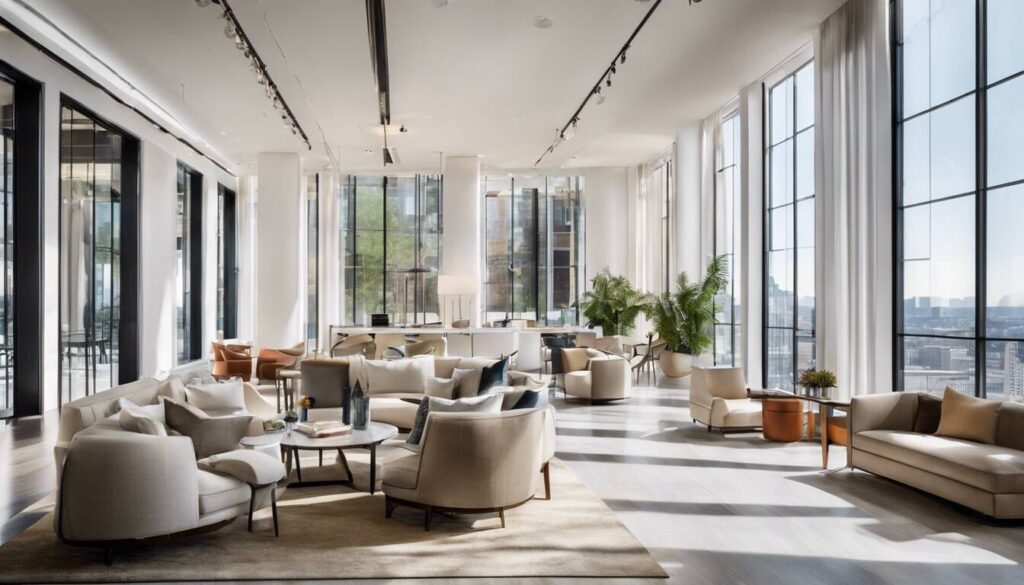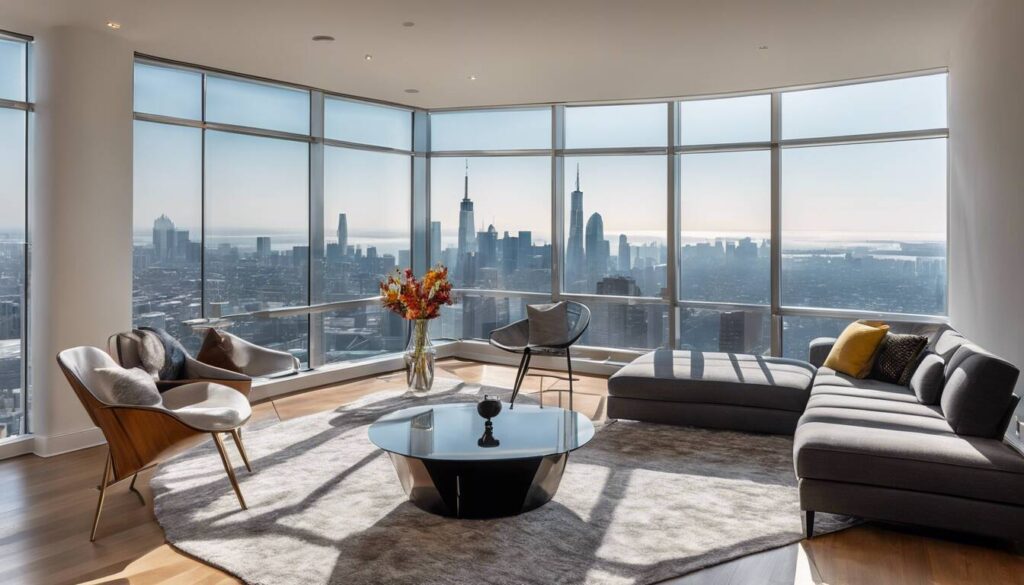Interior design networking and partnerships are like connecting the dots in an intricate design. This network consists of skilled industry professionals, such as fellow designers, architects, suppliers, and contractors. Just as each stroke in a pattern adds depth and beauty to a space, each connection within your network is an opportunity for collaboration, growth, and exposure. Ever noticed how carefully arranged decor accented by the right lighting can make a room glow? Similarly, a well-nurtured network can illuminate your business in ways you might not have imagined. Now, let’s delve into how to build these illuminating connections.
Interior designers can effectively network and form partnerships by attending trade shows and industry events, reaching out to complementary professionals such as architects and contractors, and joining relevant trade groups and associations. Additionally, hosting open houses or lunch and learn events can create opportunities for meaningful professional relationships.

Define Interior Design Networking and Partnerships
When we discuss networking and partnerships, it’s about building professional relationships within the industry—designers, architects, suppliers, and contractors. These connections form the backbone of a designer’s career, offering benefits such as collaboration opportunities and business growth.
The essence of networking is about forming genuine, mutually beneficial connections that go beyond exchanging business cards. It’s not just about what others can do for you but also what you can offer them. By nurturing these relationships with trust and respect, designers can create a supportive and collaborative environment within the industry.
Importance of Networking
One important aspect is how networking plays a crucial role in expanding one’s reach and gaining exposure. When you build a strong network, it opens doors to new opportunities for projects and collaborations that would otherwise remain undiscovered. A widened network provides access to resources, allowing designers to tap into a broader spectrum of skills, materials, and expertise.
For instance, connecting with suppliers might introduce you to innovative materials or products that could set your designs apart. Moreover, collaborations with architects or contractors might lead to more comprehensive project solutions that cater to diverse client needs.
Building Long-term Partnerships
Partnerships are an extension of networking but are distinct in their focus on sustained cooperation between parties. Instead of fleeting interactions, partnerships entail deeper levels of commitment and shared goals. By collaborating with complementary professionals such as architects or contractors, interior designers open up avenues for new clients and projects.
Fostering long-term partnerships is an integral part of growing an interior design business. These trusted relationships create a consistent flow of opportunities and add credibility to your brand.
Moreover, partnering with other designers can lead to joint ventures on larger projects that leverage individual strengths for collective success. This collaborative approach allows for a pooling of resources and expertise that helps tackle ambitious projects with more efficiency and creativity.
In conclusion, networking isn’t just about making acquaintances—it’s about creating meaningful connections that foster growth, learning, and collaboration within the interior design space. Forming lasting partnerships paves the way for sustained success by leveraging shared expertise and resources for mutual benefit.
Moving beyond the foundational principles of networking and partnerships, let’s now explore effective approaches to build industry connections that can elevate your career as an interior designer.
Effective Approaches to Build Industry Connections
When it comes to building a solid network within the interior design industry, attending trade shows and events is like having a secret treasure map—it leads you straight to valuable connections and a wealth of knowledge. The industry is abuzz with events that showcase the latest trends, products, and services—each providing golden opportunities to expand your professional circle.
Trade shows such as High Point Market, NeoCon, and Design Miami are not only platforms for discovering the newest innovations and materials but are also fertile ground for fostering connections with potential partners. These events enable you to meet influential professionals, gain insights into the latest industry trends, and establish rapport with leaders and insiders in the field. By being present at these events, you position yourself at the forefront of industry developments, gaining a deeper understanding of what’s happening on a global scale.
Imagine walking through the vibrant displays at High Point Market, engaging in conversations with fellow designers, architects, suppliers, and potential clients. Each interaction presents an opportunity for collaboration or partnership that could significantly elevate your career.
Apart from trade shows, becoming a member of professional organizations like the International Interior Design Association (IIDA), American Society of Interior Designers (ASID), or National Kitchen and Bath Association (NKBA) has its own set of advantages. These groups act as incubators for thought exchange, providing forums for members to learn from each other’s experiences and gain valuable knowledge about industry practices.
Benefits of Joining Professional Organizations
- Networking: Being part of industry-specific groups puts you in direct contact with like-minded professionals who share similar ambitions and challenges. This network could be a source of new ideas, collaborations, or even potential projects.
- Access to Resources: Professional organizations often offer access to valuable resources such as educational materials, business support services, mentorship programs, and job boards.
- Credibility: Membership in these organizations helps establish credibility within the industry. It communicates a commitment to professionalism and ethical practices.
Furthermore, these group memberships can lead to invitations for industry-related events which act as fertile ground for networking and partnerships. Imagine being invited to an exclusive event organized by one of these associations where you can mingle with influencers and prospective partners in a more intimate setting—it’s the perfect setting to forge meaningful professional relationships.
Both attending trade shows and joining professional organizations lay down the foundation for expanding your network within the interior design industry—but there’s more we can explore in our quest to build robust industry connections.
Ways to Showcase Your Work

Building a robust online presence is vital in today’s digital age. It’s not sufficient to merely have a portfolio; you need to present it in an engaging and professional manner. Your website is essentially your digital storefront, where potential partners and clients can catch a glimpse of your expertise and design style.
When creating your professional portfolio website, ensure to include high-quality images of your previous projects, along with detailed descriptions that highlight your design process and the unique elements of each project. Additionally, incorporating client testimonials adds credibility and showcases your ability to deliver exceptional results. A visually appealing and informative website can leave a lasting impression, making it more likely for potential partners or clients to reach out to you.
Furthermore, social media platforms provide an excellent opportunity to engage with a wider audience and establish your brand in the interior design industry. Instagram and Pinterest are visual-centric platforms that allow designers to share their work, connect with potential collaborators, and showcase their expertise through captivating content.
On Instagram, regularly posting high-quality images of your design projects accompanied by relevant and engaging captions can draw attention to your work. Utilize Instagram Stories and Reels to offer behind-the-scenes glimpses into your design process and share valuable insights with your audience. Similarly, Pinterest serves as a digital mood board where you can curate design ideas, inspirations, and trends, positioning yourself as an industry expert while also connecting with like-minded individuals.
For instance, sharing before-and-after transformations or design sketches on these platforms not only highlights your creative process but also allows you to interact with potential partners or clients who may be seeking inspiration for their own projects.
Consistent engagement with your audience on social media platforms demonstrates your passion for design, increases brand visibility, and fosters lasting connections within the industry. By staying active and relevant on these platforms, you can effectively showcase your work to a broader audience and attract potential partners interested in collaborating on future projects.
By harnessing the power of digital platforms such as a professional portfolio website and social media channels, you have the means to exhibit creativity, expertise, and a unique design vision to prospective partners and clients, ultimately strengthening your position within the interior design industry.
Developing a Successful Interior Design Networking Strategy
Networking transcends merely attending events and distributing business cards; it’s about forging relationships that can propel your interior design career forward. To do this successfully, it’s crucial to establish clear goals for what you want to achieve through networking and partnerships.
Set Clear Goals
Establishing clear objectives will steer your networking efforts. Whether you’re seeking new clients, seeking valuable industry insights, or expanding your professional circle, defined goals will keep you focused and make your networking endeavors more purposeful.
For example, if your goal is to find new clients, your networking actions might involve reaching out to real estate agents, architects, and fellow interior designers who could potentially refer clients to you. On the contrary, if you’re aiming to gain industry insights, attending trade shows and events can provide valuable opportunities to connect with experts and stay updated on the latest trends and innovations.
Be Proactive
Initiating conversations, following up with contacts, and actively seeking opportunities to connect with potential partners are crucial elements of a successful networking strategy. It demonstrates your eagerness to build mutually beneficial relationships and lays the foundation for long-term collaborations.
After meeting new people, sending a follow-up email expressing your pleasure at meeting them and suggesting a follow-up conversation or meeting can go a long way. It shows that you value the connection and are committed to building meaningful relationships.
Being proactive also entails taking the initiative to offer value to your network. If you come across an article or resource that may benefit someone in your network, sharing it without expecting anything in return showcases your willingness to contribute and adds depth to your professional relationships.
In summary, setting clear goals and being proactive in cultivating meaningful connections are crucial elements of a successful networking strategy that will help you lay a solid foundation for growth in the interior design industry.
As we’ve laid the groundwork for establishing fruitful connections, let’s now delve into the myriad benefits of nurturing industry partnerships.
Benefits of Interior Design Networking in Industry Partnerships
When you team up and collaborate with other professionals in your industry, it opens doors to a world of opportunities, breaking the isolation of working alone. Instead, you become part of a collective of skilled individuals supporting and promoting each other, ultimately impacting the growth and success of your interior design business.
Access to New Opportunities
Partnerships provide access to new avenues that might have previously been out of reach. Referrals from professional peers within the industry carry significant weight, signaling trust and confidence to potential clients and often leading to new projects. Additionally, collaborating with industry partners opens the door to collaborative projects, offering fresh perspectives and innovative ideas for design solutions.
Furthermore, being part of an industry network gives you exposure to new clients through your partner’s services or clientele that complement your own—forming an alliance broadens your pool of potential clients and enriches your professional portfolio.
Knowledge Exchange
Effective partnerships offer a treasure trove of insights, best practices, and innovative ideas without limits—the essential ingredients for staying relevant in the ever-changing interior design industry. Forming partnerships cultivates an environment ripe for knowledge exchange, where experiences are shared, expertise is learned from, and where you stay at the forefront of industry trends.
For instance, imagine having expertise in modern home office design but lacking experience in incorporating sustainable materials. Partnering with someone who specializes in eco-friendly designs presents an opportunity to expand your skills and knowledge base into a relevant area.
The power of collaboration lies in cultivating a culture of mutual support, growth, and enrichment within the industry. The more connections and partnerships you establish, the richer your professional journey becomes.
Together, these benefits demonstrate that building strong industry partnerships enriches your business by opening doors to new opportunities, fostering collaborative projects, expanding your client base, and facilitating ongoing knowledge exchange—all essential elements for growing as a successful interior designer.
Collaborating with Industry Professionals
As an interior designer, your ability to collaborate and form alliances with other industry professionals can significantly impact your success. Working with complementary professionals such as architects, real estate agents, and suppliers opens up a world of opportunities to expand your network, learn from others, and create unique value for your clients.
When you connect with architects, understanding each other’s perspectives and expertise allows for effective collaboration to create cohesive and functional spaces that seamlessly integrate both interior and architectural elements. This enhances the value offered to your clients and elevates the overall quality of your projects.
Forming partnerships with real estate agents can open doors to new client opportunities. Real estate agents often work with homeowners who are seeking to revamp their interiors before selling or after purchasing a new property. Establishing strong relationships with these professionals positions you as a go-to interior designer for their clients, expanding your client base and securing new projects.
Moreover, suppliers play a crucial role in the success of interior design projects. Collaborating closely with suppliers keeps you updated on the latest materials, finishes, and decor trends, providing a competitive edge in delivering innovative design solutions. Building strong partnerships with reliable suppliers also ensures streamlined project management and access to high-quality resources, ultimately enhancing the overall efficiency and success of your projects.
For instance, imagine teaming up with a local architectural firm for a residential project. By merging design expertise with their architectural insights, co-created aesthetically pleasing spaces align perfectly with the architectural framework. This collaborative approach not only amplifies the appeal of the living spaces but also demonstrates a holistic approach to design that enhances the overall functionality and aesthetic appeal of the property.
In summary, by collaborating with architects, real estate agents, and suppliers, you broaden your horizons within the industry, gain access to valuable resources, and unlock unprecedented opportunities for professional growth. These partnerships not only expand your network but enrich your projects by integrating diverse expertise, ultimately positioning you as a versatile and sought-after interior designer in the competitive market.
Curious about how to build strong relationships with the journalists? Check out our recent post: How to Build Relationships with Journalists: An Ultimate Guide
Now, let’s uncover effective strategies for identifying and recruiting potential partners with whom you can cultivate mutually beneficial working relationships.
Interior Design Networking for Recruiting Potential Partners
When it comes to finding potential partners, it’s crucial to keep an eye out for individuals whose skills complement your own. Look for people who bring something different to the table—qualities that can enhance your services and add value to your clients’ experience. Perhaps you’re excellent at creating stunning visual designs but lack experience in project management. In this case, consider seeking someone who excels in project management to complement your skill set.
This cross-disciplinary collaboration can truly elevate your work and provide a more holistic service to your clients. When partnering with someone whose skills are complementary to yours, it creates a dynamic synergy where both parties can learn from each other and create a stronger offering as a team.
For instance, if you specialize in residential interior design, you may benefit from partnering with an architect who has a strong understanding of structural design. This partnership could allow you to seamlessly integrate your interior design concepts with architectural elements, resulting in a beautifully cohesive and functional living space for your clients.
Leveraging Recommendations
One of the most effective ways to spot potential partners is by leveraging recommendations from trusted contacts or industry peers. The power of referrals should not be underestimated—you may discover hidden gems through word-of-mouth recommendations from others in the industry.
Keep in mind that industry professionals who come highly recommended by others likely have a proven track record of professionalism and excellence. By tapping into these networks and seeking referrals, you can identify potential partners who have already demonstrated their capabilities and reliability in their respective fields.
Imagine receiving a glowing recommendation from a fellow interior designer about a skilled contractor known for their impeccable craftsmanship and commitment to deadlines. This kind of endorsement can be invaluable in identifying potential partners who align with your standards of quality and professionalism.
Summary of Interior Design Networking
In the intricate tapestry of interior design, networking and forming partnerships are essential threads that enrich the fabric of a designer’s career. By forging connections with architects, suppliers, and fellow designers, professionals can tap into a vibrant ecosystem of creativity and innovation. These relationships not only enhance project outcomes through shared expertise but also open new avenues for business growth and personal development. Through active engagement in trade shows, professional associations, and collaborative projects, designers can build a network that not only supports their immediate needs but also paves the way for future opportunities.
